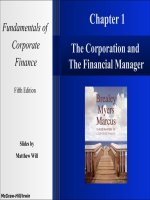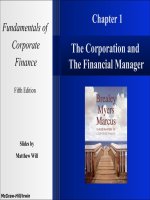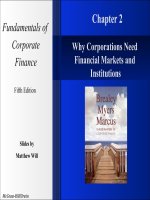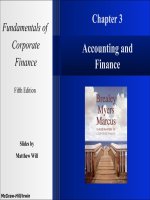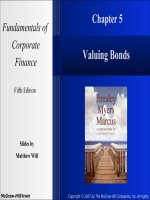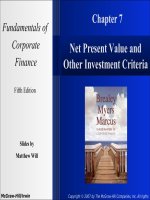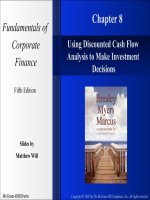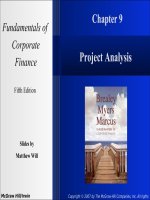Solution fundamentals of corporate finance brealy 4th chapter text solutions ch 6
Bạn đang xem bản rút gọn của tài liệu. Xem và tải ngay bản đầy đủ của tài liệu tại đây (209.06 KB, 20 trang )
Solutions to Chapter 6
Valuing Stocks
1.
No. The dividend discount model allows for the fact that firms may not currently
pay dividends. As the market matures, and Rogers Wireless Communication’s
growth opportunities moderate, investors may justifiably believe that Rogers
Wireless will enjoy high future earnings and will pay dividends then. The stock
price today can still reflect the present value of the expected per share stream of
dividends.
2.
Dividend yield = Expected dividend/Price = DIV1/P0
So: P0 = DIV1/dividend yield
P0 = $2.4/.08 = $30
3.
a.
The typical preferred stock pays a level perpetuity of dividends. The expected
dividend next year is the same as this year’s dividend, $7. Thus the dividend
growth rate is zero and the price today is:
P0 = D1/r = 7/.12 = $58.33
b. The expected dividend in two years is this year’s dividend, $7.
P1= D2/r = 7/.12 = $58.33
c. Dividend yield = $7/$58.33 = .12 =12%
Expected capital gains = 0
Expected rate of return = 12%
4. r = DIV1/P0 + g = 8% + 5% = 13%
5.
The value of a common stock equals the present value of dividends received out
to the investment horizon, plus the present value of the forecast stock price at the
horizon. But the stock price at the horizon date depends on expectations of
dividends from that date forward. So even if an investor plans to hold a stock for
only a year for two, the price ultimately received from another investor depends
on dividends to be paid after the date of purchase. Therefore, the stock’s present
value is the same for investors with different time horizons.
6-1
Copyright © 2006 McGraw-Hill Ryerson Limited
6.
a. P0 = r = + g
r = + .04 = .14 = 14%
b. P0 = 2.50/(.165 .04) = $20
7.
The dividend yield is defined as the annual dividend (or the annualized current
dividend) divided by the current price. The current annual dividend is ($2 4) = $8 and
the dividend yield is:
DIV1/P0 = .048
$8/ P0 = .048 P0 = $8/.048 = $166.7
To work with the quarterly dividend, divide the dividend yield by 4 and repeat the
above steps:
Quarterly DIV/P0 = .048/4 = .012 $2/ P0 = .012 P0 = $2/.012 = $166.7
8.
Weak, semi-strong, strong, fundamental, technical
9.
True. The search for information and insightful analysis is what makes investor
assessments of stock values as reliable as possible. Since the rewards accrue to the
investors who uncover relevant information before it is reflected in stock prices,
competition among these investors means that there is always an active search on for
mispriced stocks.
10.
a.
DIV1 = $1 1.04 = $1.04
DIV2 = $1 1.042 = $1.0816
DIV3 = $1 1.043 = $1.1249
b.
P0 = DIV1/(r g) = = $13
c.
P3 = DIV4/(r g) = = $14.6237
6-2
Copyright © 2006 McGraw-Hill Ryerson Limited
d. Your payments are:
DIV
Sales Price
Total cash flow
PV of cash flow
Year 1
1.04
Year 2
1.0816
1.04
1.0816
Year 3
1.1249
14.6237
15.7486
.9286
.8622
11.2095
Sum of PV = $13.00, the same as your answer to (b).
11.
Dividend growth rate, g = return on equity × plowback ratio:
g = .15 .40 = .06
r = + g = + .06 = .16 = 16%
12.
a.
P0 = = = $21
P0 = = $30
The lower discount rate makes the present value of future dividends higher,
raising the value of the stock.
13.
r = + g g = r - = .14 – = .04 = 4%
14.
a.
r = + g = + .03 = .0926 = 9.26%.
b.
If r = .10, then .10 = 1.64(1.03)/27 + g.
c.
g = Return on equity plowback ratio
5% = Return on equity .4
Return on equity = = = 12.5%
So g = .0374 = 3.74%
15.
P0 = DIV1/(r g)
= $2/(.12 – .06) = $33.33
16.
a. P0 = DIV1/(r g) = 3/[.15 – (.10)] = 3/.25 = $12
b. P1 = DIV2/(r g) = 3(1 .10)/.25 = $10.80
6-3
Copyright © 2006 McGraw-Hill Ryerson Limited
c. return = =
= .150 = 15.0%
d. “Bad” companies may be declining, but if the stock price already reflects this fact,
the investor still can earn a fair rate of return, as we saw in part c.
17.
a.
(i) reinvest 0% of earnings: g = 0 and DIV1 = $5:
P0 = = = $33.33
(ii) reinvest 40%: g = 15% .40 = 6% and DIV1 = $5 (1 – .40) = $3:
P0 = $3/(.15 – .06) = $33.33
(iii) reinvest 60%: g = 15% .60 = 9% and DIV1 = $5 (1 – .60) = $2:
P0 = 2/(.15 – .09) = $33.33
b.
(i) reinvest 0%: P0 = 5/(.15 – 0) = $33.33
PVGO = $0
(ii) reinvest 40%: P0 = = $42.86
PVGO = $42.86 – $33.33 = $9.53
(iii) reinvest 60%: P0 = = $66.67
PVGO = $66.67 – $33.33 = $33.34
c. In part (a), the return on reinvested earnings is equal to the discount rate.
Therefore, the NPV of the firm’s new projects is zero, and PVGO is zero in all
cases, regardless of the reinvestment rate. While higher reinvestment results in
higher growth rates, it does not result in a higher value of growth
opportunities. This example illustrates that there is a difference between
growth and growth opportunities.
In part (b), the return on reinvested earnings is greater than the discount rate.
Therefore, the NPV of the firm’s new projects is positive, and PVGO is
positive. PVGO is higher when the reinvestment rate is higher in this case,
since the firm is taking greater advantage of its opportunities to invest in
positive NPV projects.
6-4
Copyright © 2006 McGraw-Hill Ryerson Limited
18.
Stock exchange information
Tips: When accessing stock exchange information at www.fibv.com, you don’t actually
click on “Member” but rather place your cursor on the word. You click on the region and
stock exchange of interest. Also, remind the students to click on the symbol of the stock
exchange to connect to the Web site of that exchange.
Expected results: Students learn about variety of stock exchanges around the world and
the types of information provided.
19.
Hollywood stock exchange
Expected result: A fun experience trading securities.
20.
a.
P0 = + + = 18.10
b.
DIV1/P0 = $1/18.10 = .0552 = 5.52%
21.
a.
b.
c.
22.
Stock A
Stock B
Payout ratio
$1/$2 = .50
$1/$1.50 = .67
g = ROE plowback
15% .5 = 7.5%
10% .333 = 3.33%
Price = DIV1/(r g)
= $14.33
= $8.85
Note: We interpret “recent” to mean in the past. The current stock price
depends on future dividends – so the next dividend must be 1 + g times higher.
a.
ROE plowback ratio = 20% .3 = 6%
b.
E = $2, plowback ratio = .3, r = .12, g = .06 P0 = = $23.33
c.
No-growth value = E/r = $2/.12 = $16.67
PVGO = P0 no-growth value = $23.33 $16.67 = $6.66
d.
P/E = 23.33/2 = 11.665
e.
If all earnings were paid as dividends, price would equal the no-growth value,
$16.67, and P/E would be 16.67/2 = 8.335.
23.
f.
High P/E ratios reflect expectations of high PVGO.
a.
=$60
b.
No-growth value = E/r = $6.20/.12 = $51.67
PVGO = P0 no-growth value = $60 51.67 = $8.33
6-5
Copyright © 2006 McGraw-Hill Ryerson Limited
24. a.
25.
Earnings = DIV1 = $4. Growth rate g = 0.
P0 = = $33.33
P/E = 33.33/4 = 8.33
b.
If r = .10, P0 = = 40, and P/E increases to 40/4 = 10
A decrease in the required rate of return, holding dividends constant, raises the
stock price and the P/E ratio.
a.
Plowback ratio = 0 implies DIV1 = $3 and g = 0.
Therefore, P0 = = $30
and the P/E ratio is 30/3 = 10.
b.
Plowback ratio = .40 implies DIV1 = $3(1 – .40) = $1.80, and g = 10% .40 = 4%.
Therefore P0 = $1.80/(.10 – .04) = $30
and the P/E ratio is 30/3 = 10.
c.
Plowback ratio = .80 implies DIV1 = $3(1 – .80) = $.60, and g = 10% .80 = 8%.
Therefore P0 = $.60/(.10 – .08) = $30
and the P/E ratio is 30/3 = 10.
Regardless of the plowback ratio, the stock price = $30 because all projects
offer return on equity just equal to the opportunity cost of capital.
26.
27.
a.
P0 = DIV1/(r g) = $5/(.10 – .06) = $125
b.
If Trendline followed a zero-plowback strategy, it could pay a perpetual
dividend of $8. Its value would be $8/.10 = $80, and therefore, the value of
assets in place is $80. The remainder of its value must be due to growth
opportunities, so PVGO = $125 – $80 = $45.
a.
g = 20% .30 = 6%
DIV1 = $2(1 – .30) = $1.40
P0 = DIV1/(r g) = $1.40/(.12 .06) = $23.33
P/E = 23.33/2 = 11.665
6-6
Copyright © 2006 McGraw-Hill Ryerson Limited
b.
If the plowback ratio is reduced to .20, g = 20% .20 = 4%
DIV1 = $2(1 – .20) = $1.60
P0 = DIV1/(r g) = $1.60/(.12 – .04) = 20
P/E = 20/2 = 10
P/E falls because the firm’s value of growth opportunities is now lower: It
takes less advantage of its attractive investment opportunities.
28.
29.
c.
If the plowback ratio = 0, g = 0, and DIV1 = $2,
P0 = $2/.12 = 16.67 and E/P = 2/16.67 = .12
a.
DIV1 = 2.00
DIV2 = 2(1.20) = 2.40
DIV3 = 2(1.20)2 = 2.88
b.
This could not continue indefinitely. If it did, the stock would be worth an
infinite amount. Another way to think about the feasible perpetual growth rate
is to compare the company’s growth rate with the growth rate of the economy.
The economy grows about 3% a year. To grow faster than the economy as a
whole is feasible when the company is small. However, to continue to grow at
20%, the company must take over other companies and eventually become the
entire economy. But in the long run, it still can only grow as quickly as the
entire economy. So it is impossible to grow at 20% in perpetuity. Think about
Microsoft – it has had phenomenal growth partly by acquiring other
companies and partly by growing its own businesses. However, even if it were
to own all of the companies in the world, eventually its growth rate would fall
to the growth rate of the world economy. We are assuming that Bill Gates is
not able to successfully market his software to still to be discovered alien
worlds!! Finally, note too that the constant dividend growth model fails when
the assumed perpetual growth rate is greater than the discount rate.
a.
Book value = $100 million
PV = 2/1.10 = 1.818
PV = 2.40/1.102 = 1.983
PV = 2.88/1.103 = 2.164
First year earnings = $100 million .24 = $24 million
Dividends = Earnings (1 – plowback ratio) = $12 million
g = return on equity plowback ratio = .24 .50 = .12
Market value = = $400 million
6-7
Copyright © 2006 McGraw-Hill Ryerson Limited
Market-to-book ratio = $400/$100 = 4
b.
Now g falls to .10 .50 = .05, first year earnings decline to $10 million (=$100
million × .1), and dividends decline to $5 million (=$10 million × .5).
Market value = = $50 million
Market-to-book ratio = ½
This makes sense, because the firm now earns less than the required rate of return
on its investments. Its project is worth less than it costs.
30.
P0 = +
+ = $16.59
31.
a.
DIV1 = $2 1.20 = $2.40
b.
DIV1 = $2.40
DIV2 = $2.88
DIV3 = $3.456
P3 = = $32.675
P0 = +
+ = $28.02
c.
P1 = +
= $29.825
d.
Capital gain = P1 P0 = $29.825 $28.02 = 1.805
r = = .15 = 15%
32.
a.
Note: If students carry at least 4 decimal places, the results will be clearer.
Also, it is easier to solve the prices in reverse order.
DIV1 = $.5
DIV2 = $.5
DIV4 = $.5 × 1.04 = $.52
DIV3 = $.5
DIV5 = $.5 × 1.042 = $.5408
P4 = = = $7.7257
P3 = = = $7.4286
P2 = = = $7.1429
P1 = = = $6.8855
P0 = = = $6.6536
b.
Year 0
6-8
Copyright © 2006 McGraw-Hill Ryerson Limited
Dividend yield = = = .07515
Capital gains yield = = = .03485
Dividend yield + capital gains yield = .07515 + .03485 = .11
Year 1
Dividend yield = = = .07262
Capital gains yield = = = .03738
Dividend yield + capital gains yield = .07262 + .03738 = .11
Year 2
Dividend yield = = = .0700
Capital gains yield = = = .0400
Dividend yield + capital gains yield = .07 + .04 = .11
Year 3
Dividend yield = = = .0700
Capital gains yield = = = .0400
Dividend yield + capital gains yield = .07 + .04 = .11
Yes, each year the sum of the dividend yield and the capital gains yield equal 11
percent, the required rate of return. Once the company hits constant growth rate of
4 percent, both the dividend yield and the capital gains yield also become constant.
33.
DIV1 = dividend payout × earnings1 = .4 × $3 = $1.2
DIV2 = dividend payout × earnings2 = .4 × $3 × 1.1 = $1.32
DIV3 = dividend payout × earnings3 = .4 × $3 × 1.12 = $1.452
DIV4 = dividend payout × earnings4 = .4 × $3 × 1.13 = $1.5972
DIV5 = dividend payout × earnings5 = .4 × $3 × 1.14 = $1.75692
P0 = + + + + × = $13.95
34.
a.
BCE preferred shares
Expected results: Students use real data to calculate the current expected (or
6-9
Copyright © 2006 McGraw-Hill Ryerson Limited
required) rate of return.
b.
CIBC preferred shares
Expected results: Students will quickly learn that the www.globeinvestor.com does
not do a good job on preferred shares. The dividend payouts are rounded to 2
digits and hence do not match well the actual dividends listed on the CIBC Web
site.
35.
Expected Results: ATY-T is ATI Technologies and SRF-T is Sun-Rype Foods.
Emphasize to the students that they should describe the businesses of these
companies in their own words. Encourage students to think about how each
company presents its products. Students will look at the investor pages to see the
information they provide.
36.
Tips: The Web site has changed since the textbook went to press. Instruct students to
click on “Access Public Filings” to get to the insider information. General information
on the insiders is found at “View Insider Information”. To see current trading by the
insiders, click on “View Summary Reports”. Pick “insider transaction detail” and click
on “next”. Then identify the insider (you will see “insider family” as an option) and go
to the bottom of the page and hit “search”. On the next screen select “view”. The
summary report shows the insider trading of each security of various companies
(“issuers”). For example, in November 2005, the first issuer listed for Frank Stronach
was Decoma International Inc. Mr. Stronach is director or senior officer holding at least
10% of the Class A subordinate voting shares. The report shows transactions of Mr.
Stronach.
Expected results: Students will see the information available and wonder whether they
can trade on this – do stock purchases and sales provide information of value to outside
investors?
37.
Before-tax rate of return:
= =
= .078 = 7.8%
After-tax rate of return:
=
= = .0596 = 5.96%
38.
a.
An individual can do crazy things, but still not affect the efficiency of markets. An
irrational person can give assets away for free or offer to pay twice the market
value. However, when the person’s supply of assets or money runs out, the price
6-10
Copyright © 2006 McGraw-Hill Ryerson Limited
will adjust back to its prior level (assuming there is no new, relevant information
released by his/her action). If you are lucky enough to trade with such a person you
will receive a positive gain at that investor’s expense. You had better not count on
this happening very often though. Fortunately, an efficient market protects
irrational investors in cases less extreme than the above. Even if they trade in the
market in an “irrational” manner, they can be assured of getting a fair price since
the price reflects all information.
b.
Yes, and how many people have dropped a bundle? Or more to the point, how
many people have made a bundle only to lose it later? People can be lucky and
some people can be very lucky; efficient markets do not preclude this
possibility. Furthermore, how much risk did they take? You expect to earn a
higher return if you take on more market (beta) risk.
c.
Investor psychology is a slippery concept, more often than not used to explain
price movements which the individual invoking it cannot personally explain.
Even if it exists, is there any way to make money from it? If investor
psychology drives up the price one day, will it do so the next day also? Or will
the price drop to a “true” level? Almost no one can tell you beforehand what
“investor psychology” will do. Theories based on it have no content.
39.
There are several thousand mutual funds in Canada and the United States. With so many
professional managers, it is no surprise that some managers will demonstrate brilliant
performance over various periods of time. As an analogy, consider a contest in which
10,000 people flip a coin 20 times. It would not surprise you if someone managed to flip
heads 18 out of 20 times. But it would be surprising if he could repeat that performance.
Similarly, while many investors have shown excellent performance over relatively short
time horizons, and have received favourable publicity for their work, far fewer have
demonstrated consistency over long periods.
40.
If the firm is stable and well run, its price will reflect this information, and the stock may
not be a bargain. There is a difference between a “good company” and a “good stock.”
The best buys in the stock market are not necessarily the best firms; instead, you want
firms that are better than anyone else realizes. When the market catches up to your
assessment and prices adjust, you will profit.
41.
Remember the first lesson of market efficiency: The market has no memory. Just
because long-term interest rates are high relative to past levels doesn’t mean they won’t
go higher still. Unless you have special information indicating that long-term rates are
too high, issuing long-term bonds should be a zero-NPV transaction. So should issuing
short-term debt or common stock.
42.
The stock price will fall. The original price would reflect an anticipation of a 25%
increase in earnings. The actual increase is a disappointment compared to original
expectations.
6-11
Copyright © 2006 McGraw-Hill Ryerson Limited
43.
50 =
g = .15 – = .10
g = .10 = return on equity plowback ratio = return on equity .60
return on equity = .10/.60 = .1667 = 16.67%
44.
a.
P0 = +
DIV1 = $1
DIV2 = $2
P2 = = = $30
P0 = + = $26.40
b.
Next year, P1 = = = $28.57
c.
return = = = .12
= + = .12
45.
DIV1 = $1
DIV2 = $2
DIV3 = $3
g = .06 Therefore P3 = 3(1.06)/(.14 – .06) = $39.75
P0 = + + = $31.27
46. a.
b.
DIV1 = $4, and g = 4%
Expected return = DIV1/P0 + g = 4/100 + 4% = 8%
Since DIV1 = Earnings (1 – plowback ratio),
Earnings = DIV1/(1 – plowback ratio) = 4/(1 – .4) = $6.667
6-12
Copyright © 2006 McGraw-Hill Ryerson Limited
If the discount rate is 8% (the expected return on the stock), then the no-growth
value of the stock is 6.667/.08 = $83.34. Therefore PVGO =$100 – $83.34 = $16.66
c.
For the first 5 years, g = 10% .8 = 8%. Thereafter, g = 10% .4 = 4%
Year
Earnings
plowback
DIV
g
1
6.67
.80
1.33
.08
2
7.20
.80
1.44
.08
3
7.78
.80
1.56
.08
4
8.40
.80
1.68
.08
5
9.07
.80
1.81
.08
6 ...
9.80
.40
5.88
.04
After year 6, the plowback ratio falls to .4 and the growth rate falls to 4
percent. [We assume g = 8% in year 5 (i.e., from t = 5 to t = 6), since the
plowback ratio in year 5 is still high at b = .80. Notice the big jump in the
dividend when the plowback ratio falls.] By year 6, the firm enters a steadygrowth phase, and the constant-growth dividend discount model can be used
to value the stock.
The stock price in year 6 will be
P6 = = = $152.88
P0 = + + + + + = $106.22
47.
a.
DIV1 = 1.00 1.20 = $1.20
DIV2 = 1.00 (1.20)2 = $1.44
DIV3 = 1.00 (1.20)3 = $1.728
DIV4 = 1.00 (1.20)4 = $2.0736
b.
P4
= DIV5/(r g) = DIV4(1 + g)/(r g)
= 2.0736(1.05)/(.10 – .05) = $43.55
c.
P0
= + + + = $34.74
d.
DIV1/P0 = 1.20/34.74 = .0345 = 3.45%
e.
Next year the price will be:
+ + = $37.01
f.
return =
= = .10
6-13
Copyright © 2006 McGraw-Hill Ryerson Limited
The expected return equals the discount rate (as it should if the stock is fairly priced).
48.
Before-tax rate of return
= = = .1 = 10%
After-tax dividend:
Grossed up dividend = 1.25 × 2 = 2.50
Gross federal tax = .22 × 2.50 = .55
Federal tax credit = .1333 × 2.50 = .3333
Net federal tax = .55 - .3333 = .2167
Gross provincial tax = .119 × 2.50 = .2975
Provincial tax credit = .066 × 2.50 = .165
Net provincial tax = .2975 - .165 = .1325
Total dividend tax = .2167 + .1325 = .3492
After-tax dividend = 2 – .3492 = 1.6508
Capital gains tax = .5 × (.22 + .119) × (53 – 50) = .5085
After-tax capital gains = 53 – 50 – .5085 = 2.4915
After-tax rate of return
=
=
49.
= .0828 = 8.28%
Assume taxes do not change. We make the easiest reinvestment assumption: dividends
are spent as they are received and do not earn any interest. Thus, the future value of
dividends received is 2 × 3 = 6. The selling price is $55.
The before-tax rate of return is
=
()
1/3
-1=
()
1/3
- 1 = .0685 = 6.85%
Annual after-tax dividends = 2 – .3492 = 1.6508 (from question 48)
Future value of dividends received = 1.6508 × 3 = 4.9524
Capital gain tax = .5 × (.22 + .119) × (55 – 50) = .8475
The after-tax rate of return is
=
()
1/3
-1
6-14
Copyright © 2006 McGraw-Hill Ryerson Limited
=
50.
a.
()
1/3
- 1 = .0573 = 5.73%
Both of these instruments are perpetuities. Recall the price of a perpetuity is
P0 =
Rearranging the equation to find the required rate of return. The consol’s
annual cash flow is its coupon payment and the preferred share’s annual cash
flow is its dividend payment.
Consol rate of return = bond coupon/P0 = .04 × 1000/800 = .05 = 5%
Preferred share rate of return = preferred dividend/P0 = 6/120 = .05 = 5%
b.
Convert the annual cash flows to their after-tax amounts:
After-tax bond coupon = (1 - .35) × .04 × 1000 = .65 × 40 = 26
After-tax preferred dividend = (1 - .29) × 6 = 4.26
Consol after-tax rate of return = after-tax coupon/P0 = 26/800 = .0325 = 3.25%
Preferred after-tax rate of return = after-tax dividend/P0 = 4.26/120 = .0355 = 3.55%
51.
c.
With a 35% corporate tax rate, the after-tax rate of return on the consol is the
same as we calculated in (b), 3.25%. However, the corporate tax rate on
dividends received from other Canadian corporations is zero. Thus the rate of
return on the preferred shares is the before-tax rate from (a), 5%.
d.
Corporations with spare cash to invest will prefer to purchase dividend-paying
securities of Canadian corporations than corporate bonds to take advantage of
preferential dividend tax treatment.
The first dividend comes in 3 years from today and thereafter grows at a constant annual
rate of 6%. Use the constant dividend growth model to calculate the price two years
from today, P2, and then discount that price to today to today’s price, P0:
P2 = = = 12.5
P0 =× P2 = × 12.5 = 10.33
52.
[ () ]
The growing annuity formula is × 1 –
Years 1 – 4
r = 12%, g = 10%, T = 4,
6-15
Copyright © 2006 McGraw-Hill Ryerson Limited
T
C1 = DIV1 = (1 + g) × DIV0 = 1.1 × 1 = 1.1
Present value of Year 1 – 4 dividends
[ () ] = × [1 – () ]= 3.82
= × 1–
T
4
Years 5 – 14
r = 12%, g = 8%, T = 10
To get the Year 5 dividend (which is the first cash flow in the second interval of
constant growth), figure out the Year 4 dividend first. Since dividends are expected
to grow 10% a year for 4 years and then grow at 8%:
DIV4 = 1.14 × DIV0 = 1.14 × 1 = 1.4641
DIV5 = (1 + g) × DIV4 = 1.08 × 1.4641 = 1.581228
Present value of Years 5 – 14 dividends at the end of Year 4
[ () ] = × [1 – () ]= 12.0523
= × 1–
10
10
Present value of Years 5 – 14 dividends today
[ () ] = × 12.0523 = 7.66
=× × 1–
10
Year 15 and on
r = 12%, g = 5%
DIV14 = (1.08)10 × DIV4 = (1.08)10 × 1.4641 = 3.1609
DIV15 = (1.05) × DIV14 = 1.05 × 3.1609 = 3.3190
Present value of Year 15 and on dividends at the end of Year 14
= = = 47.41
Present value of Year 15 and on dividends today
= = × 47.41 = 9.70
Price today = present value of all dividends to be received
P0 = 3.82 + 7.66 + 9.70 = 21.18
53.
Event
High quality gold
Medium quality gold
No gold
PV of dividends
8 × annuity factor(9%, 20 years) = 73.03
2 × annuity factor(9%, 20 years) = 18.26
0
P0 = .4 × 73.03 + .5 × 18.26 = $38.34
54.
a.
Price on May 1, 2007 = 2.50/(.1 - .06) = 62.50
6-16
Copyright © 2006 McGraw-Hill Ryerson Limited
b.
c.
d.
Price on May 1, 2007 = 1.248/(.1 - .04) = 20.8
Price on May 1, 2006 = [1.20 + .3 × 62.50 + .7 × 20.8] = $31.37
Rate of return if R&D is successful = - 1 = 1.031 = 103.1%
Rate of return if R&D is unsuccessful = - 1 = -0.299 = -29.9%
Expected rate of return = .3 × 1.031 + .7 × (-.299) = .10 = 10%
55.
The difference in rates on long- versus short-term bonds does not necessarily reflect a
profit opportunity that would be a contradiction of the efficient market hypothesis. The
text points out that the slope of the yield curve might be a reflection of investors’
expectations of future short-term interest rates. For example, a downward sloping yield
curve, in which long-term rates are below short-term rates, might indicate that investors
anticipate that future short-term rates will be lower than today’s values. Today’s longterm rates, which reflect beliefs about the future, are therefore lower than current shortterm rates.
56.
a.
No. The split is purely a “paper transaction,” in which more shares are printed
and distributed to shareholders.
b.
No. Operating profits continue as before the split.
c.
Earnings per share will fall by half. With unchanged earnings and double the
number of shares, all per share values will fall by 50 percent.
d.
The firm’s stock price will fall by half. With unchanged total value, and
double the number of shares, price per share will fall by 50 per cent.
e.
The shareholder’s wealth should be unaffected. Each owns double the number
of shares, but the value of each share is only half of the original value.
Note: These answers are actually only part of the story. Most stock split
announcements are regarded as good news by investors, and stock prices
generally increase. This is not because investors suffer from financial
illusions, but because managers commit to splits only when they are confident
that they can maintain or increase earnings. Thus the split is good news, not
because it multiplies the number of shares, but because it reveals
management’s confidence about the future.
57.
Internet: Online dividend discount model
INTERNET UPDATE: The main page of this website has changed. To access the model,
you must now enter a stock ticker symbol. If you don't know what it is, you can look it
6-17
Copyright © 2006 McGraw-Hill Ryerson Limited
up.
Expected results: Students will see how finance practitioners implement the dividend
discount model.
58.
Standard & Poor's
Expected results: An opportunity to apply the ideas of the chapter to the real world.
Students might not be able to see sensible patterns. The real world is not as tidy as one
would like!
59.
Standard & Poor's
Expected results: An opportunity to apply the dividend growth model to actual
companies.
60.
Bonds
Bonds are perpetual, never mature. The only cash flow is interest:
Annual cash flow to bonds: Interest = $10 million/year
Required rate of return on bonds = 5%
Use the perpetuity formula to value the bonds:
Total bond market value = annual cash flow to bonds/required rate of return
= $10 million/.05 = $200 million
Current bond price = total bond market value/number of bonds
= $200 million/150,000 = $1,333.33 per bond
Shares
Shares are perpetual and cash flow never grows. The only cash flow are dividends.
Dividends = dividend payout ratio × Net income
Net income = (EBIT - Interest) - Corporate taxes = (70 million - 10 million) - taxes
Corporate taxes = tax rate × (EBIT - Interest) = .3 × (70 million - 10 million) = 18 m
Dividends = Net income = (70 million - 10 million) - 18 million = 42 million
Required rate of return on equity = 11%
Use the perpetuity to value the shares:
Total equity value = annual cash flow to shares/required rate of return
= 42 million/ .11 = $381.82 million
Current share price = total equity market value/number of shares
= $381.82 million/15 million =$25.45 per share
Solution to Minicase for Chapter 6
6-18
Copyright © 2006 McGraw-Hill Ryerson Limited
The goal is to value the company under both investment plans and to choose the
better investment plan.
Valuation based on past growth scenario
The firm has been growing at 5% per year. Notice that book value in 2009 equals
book value five years ago, at the beginning of 2005 (1.05)5. This is calculated as
(80/62.7)1/5 – 1 = .0499 = 5%. Dividends are proportional to book value and also have
grown at 5% annually over the past four years, (7.7/6.3)1/4 – 1 = .05. Dividends paid in
the most recent year, 2009, were $7.7 million and they are projected to be $8 million next
year, in 2010, if no changes are made.
To verify that this growth in dividends is feasible, calculate the sustainable growth
rate. Starting in 2010, 2/3 of earnings will be paid out as dividends, and 1/3 will be
reinvested. Therefore, the sustainable growth rate as of 2010 is
return on equity plowback ratio = 15% 1/3 = 5%
Finally, the relevant discount rate for the company’s cash flows is the 11% that
investors believe they can earn on similar-risk investments, not the 15% return on book
equity. It is great that the company earns more on its investments than investors must earn
on similar-risk investments. The share price will reflect this better performance.
However, the relevant cost of capital is the opportunity cost, the return on investments of
similar risk to Prairie Home Stores.
The value of the firm at the end of 2009 under the assumption that the past growth
is continued is therefore
Value2009 = = = $133.33 million
and the value per share is $133.33 million/400,000 = $333.33. Therefore, it is clear that
Mr. Breezeway was correct in advising his relative not to sell for book value of $200 per
share.
Valuation based on rapid growth scenario
If the firm reinvests all earnings in 2010, 2011, 2012 and 2013, dividends paid at
the end of 2014 will reach $14 million, far greater than in the constant growth scenario.
Forgoing dividends allows the company to achieve this rapid growth.
At the end of the rapid growth period, Prairie Homes will re-establish its dividend
policy of paying two-thirds of its earnings as dividends. At this point, the dividend
growth rate will fall to sustainable growth rate of 5%, which is the return on equity times
6-19
Copyright © 2006 McGraw-Hill Ryerson Limited
the plowback ratio, 15% × 1/3.
The value of the firm in 2013 will be the present value of the dividend in one
year, $14 million, divided by the required rate of return, 11%, minus the sustainable
growth rate of 5%:
Value2013 = = = $233.3 million
The value of the firm as of today, the end of 2009, is the present value of this amount.
Remember, there will be no dividend flows in the years leading up to 2014.
Value2009 = = $153.70 million
or a per share value of $153.70 million/400,000 = $384.25
Thus, it appears that the rapid growth plan is in fact preferable. If the firm follows
this plan, it will be able to go public — that is, sell its shares to the public — at a higher
price. One potential obstacle will be the family members who are not willing to give up
their dividends. However, they should be persuaded that with an active secondary market
for their shares, they will be able to sell off part of their holdings for cash.
6-20
Copyright © 2006 McGraw-Hill Ryerson Limited
